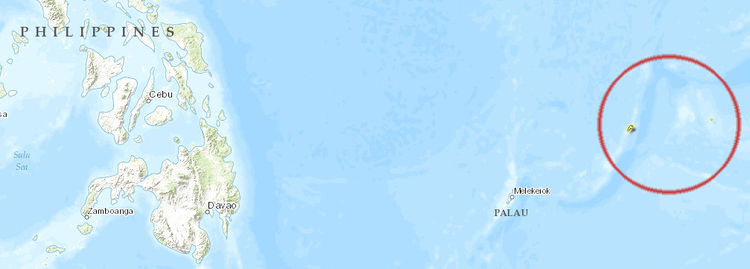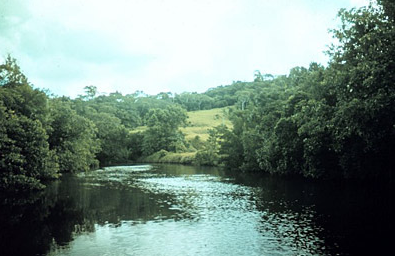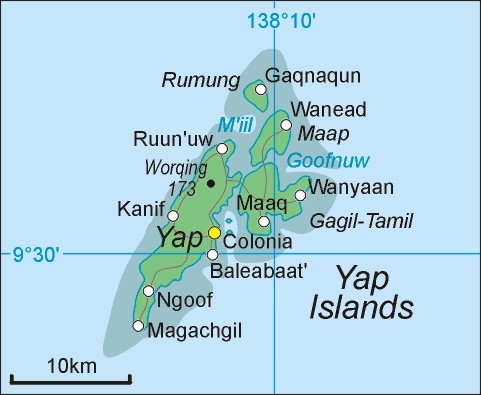Yap tropical dry forests
Much of Yap is currently open savanna resulting from high pre-contact human densities.
The remaining tropical dry forest is largely secondary and contains a mixture of native and cultivated species. The islands support several endemic species of plants and birds, some of which are threatened by human activities and introduced species.
Location and General Description
The Yap Islands group is located about 450 kilometers (km) northeast of Palau, near 10° N latitude and 140° E longitude. Yap Proper, also called "Wa’ab," consists of four islands separated by narrow channels. Three of the islands—Yap, Gagil-Tomil, and Maap—are connected by roads. The fourth, Rumung, is accessible only by boat.
Yap has a gentle topography, rising to a maximum elevation of about 175 meters (m) on Mt. Matade. Geologically, the islands are composed of two distinct sequences: ancient weathered volcanic rock and weathered metamorphic schists. The islands are surrounded by a broad fringing barrier reef.
The climate is tropical, with yearly temperatures averaging 27 ºC, and annual rainfall ranging from 2,250 to 3,400 millimeters (mm) (1981-1988). Rainfall is seasonal, with a distinct dry season lasting from January through March. The islands are subject to typhoons, and get frequent heavy rains from May through November.
 WWF The flora appears to be an attenuated version of that found on Palau. Nothing is known of the original vegetation of the area, and very little is known about the character of the vegetation prior to European contact. The islands are thought to have been mostly covered with broadleaf deciduous forests in the past. Today, forests cover 40 percent of total land area, and have been divided by Falanruw, Whitesell, et al into 3 main forest types: upland (mixed broadleaf forest), swamp, and mangrove. Another 26 percent of the land area is used for agroforestry, or tree gardens. The dominant species on these managed lands include coconut palm, breadfruit, betel nut, papaya, banana, cassava, two species of taro, and a variety of medicinal and ornamental species.
WWF The flora appears to be an attenuated version of that found on Palau. Nothing is known of the original vegetation of the area, and very little is known about the character of the vegetation prior to European contact. The islands are thought to have been mostly covered with broadleaf deciduous forests in the past. Today, forests cover 40 percent of total land area, and have been divided by Falanruw, Whitesell, et al into 3 main forest types: upland (mixed broadleaf forest), swamp, and mangrove. Another 26 percent of the land area is used for agroforestry, or tree gardens. The dominant species on these managed lands include coconut palm, breadfruit, betel nut, papaya, banana, cassava, two species of taro, and a variety of medicinal and ornamental species.
The upland forests are of low stature, with no conspicuous stratification. The canopy layer is diverse, and common species include Celtis sp., Buchanania engleriana, Campnosperma brevipetiolata, Trichospermum ikutai, Garcinia rumiyo, Pentaphalangium volkensii, Terminalia catappa, Pouteria obovata, Pangium edule, Aidia cochinchinensis, and Eurya japonica. The shrub layer below includes Psychotria, Crateva, Streblus, Glochidion, Leea, Hibiscus, Polyscias, and Ixora. In favorable, sheltered sites, the upland forest is a dense with a closed-canopy, but it becomes much more open on exposed slopes. Most of the upland forests remaining on Yap are secondary growth, containing a mixture of native and cultivated species.
Mangrove forests occur in low, sheltered areas along the coast. Mangrove species are fairly diverse and similar to those on Palau.
Biodiversity Features
The Yap Islands support a few endemic plant species, mostly of genera represented in Palau, including Drypetes yapensis, D. carolinensis, Trichospermum ikutai, Hedyotis fruticosa, Timonius albus, and Casearia cauliflora. A boxlike shrub, Myrtella bennigseniana, is endemic to the savanna environments of Yap and Guam.
Yap contains three strict endemic bird species—a monarch (Monarch sp.) and two white-eyes (Rukia sp., Zosterops sp.) as well as four additional restricted-range bird species.
The Yap flying-fox (Pteropus yapensis) is endemic to the islands, though some consider this a subspecies of Pteropus mariannus. The species is considered endangered due to hunting and typhoons.
Current Status
Human population prior to European contact is estimated to have been about 40,000, compared to the present population of about 7,000. The early inhabitants lived by swidden farming of nutrient-demanding crops such as yams. Nutrient depletion and land clearing by fire led to the spread of savanna, despite high rainfall and the presence of pioneer tree species.
The scarcest of the endemic bird species is Zosterops oleagineus, which is classified as threatened with a population estimated at fewer than 20,000 individuals in 1984. Two additional endemic bird species, the Yap monarch (Monarcha godeffroyi) and the plain white-eye (Zosterops (or Rukia) oleagineus) are classified as near-threatened.
The Yap cicadabird (Coracina tenuirostris nesiotis), which may be elevated to a separate species. A race of the common moorhen (Gallinula chloropus) may also be a threatened subspecies, depending on its origin.
Currently, there are no legally protected areas in the Yap Islands; all land is privately owned. The use of natural resources has been regulated by customary management but, as populations grow, this is becoming more problematic on Yap as it is elsewhere in the Pacific. Recommendations have been made to institute standard forestry practices, but these have not yet been put into place.
Types and Severity of Threats
All endemic bird species on the Yap Islands birds are at risk from introduced species, the most notorious being the brown tree snake Boiga irregularis, which is responsible for many extinctions on Guam. The tree sparrow Passer montanus, which was introduced in late 1970s from Eurasia, may carry exotic diseases, although there is as yet no confirmation. A major threat to bird species is loss of habitat, due to human-set fires during the dry season.
Justification of Ecoregion Delineation
This ecoregion consists of the main Yap Islands in addition to the nearby atolls of Ulithi, Ngulu, Fais, and Faraulep. Van Balgooy groups Yap, the Marianas, and the Eastern Carolines (Truk, Pohnpei, Kosrae) together based on floristic affinities. Allison does not distinguish Yap as a herpetological unit distinct from the other Micronesian islands. Birdlife International delineates Yap as an Endemic Bird Area based on the presence of 3 endemic bird species. Yap is given ecoregional status on the basis of its endemic bird fauna.
Additional information on this ecoregion
- For a shorter summary of this entry, see the WWF WildWorld profile of this ecoregion.
- To see the species that live in this ecoregion, including images and threat levels, see the WWF Wildfinder description of this ecoregion.
- World Wildlife Fund Homepage
Further Reading
- Dahl, A.L. 1986. Review of the protected areas system in Oceania. International Union for Conservation of Nature and Natural Resources, Commission on National Parks and Protected Areas, in collaboration with the United Nations Environment Programme. ISBN: 2880325099
- Falanruw, M.C., C.D. Whitesell, T.G. Cole, C.D. MacLean, A.H. Ambacher. 1987. Vegetation survey of Yap, Federated States of Micronesia. USDA, Pacific Southwest Forest and Range Experiment Station, Resource Bulletin PSW-21, Berkeley, CA.
- Flannery, T.F. 1995. Mammals of the southwest Pacific islands. Reed, Chatswood. ISBN: 0801431506
- Hilton-Taylor, C. (compiler) 2000. 2000 IUCN Red List of Threatened Species. IUCN, Gland, Switzerland. ISBN: 2831705657
- Mickleburgh, S., A.M. Hutson, P.A. Racey. 1992. Old World Fruit Bats. An Action Plan for their Conservation. IUCN/SSC Chiroptera Specialist Group, Gland, Switzerland.
- Mueller-Dombois, D. and F.R. Fosberg. Vegetation of the Tropical Pacific Islands. Springer-Verlag New York, Inc. ISBN: 038798285X
- Nakano, K., K.Pollol, L.O. Ayin. 1987. On the devastated grassland in Palau and Yap, the western Carolines. Reprint from The prompt report of the Fifth Scientific Survey of the South Pacific. Kagoshima University, Research Center for the South Pacific.
- Pratt, H.D., P.L. Bruner, and D.G. Berrett. 1987. The Birds of Hawaii and the Tropical Pacific. Princeton University Press, Princeton, NJ. ISBN: 0691023999
- Stattersfield, A.J., M.J. Crosby, A.J. Long, and D.C. Wege. 1998. Endemic bird areas of the world: priorities for biodiversity conservation. BirdLife Conservation Series No. 7. BirdLife International. Cambridge, UK. ISBN: 0946888337
| Disclaimer: This article is taken wholly from, or contains information that was originally published by, the World Wildlife Fund. Topic editors and authors for the Encyclopedia of Earth may have edited its content or added new information. The use of information from the World Wildlife Fund should not be construed as support for or endorsement by that organization for any new information added by EoE personnel, or for any editing of the original content. |

